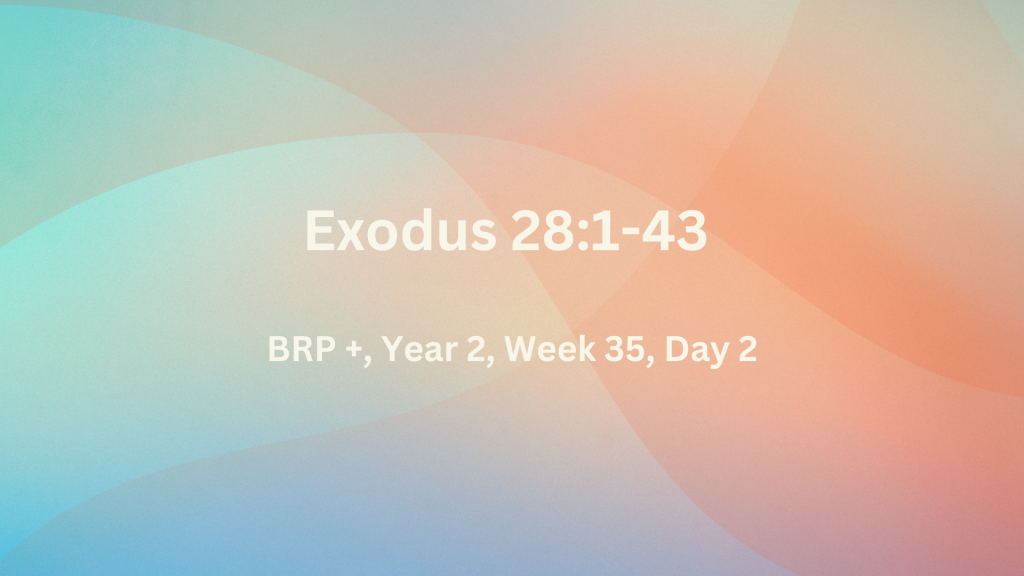Exodus 28:1-43
Q.1. Who was to be set apart for the Priesthood? What was to be portrayed by their garments? What was the ephod for? Why were the onyx stones significant? – (Exo.28:1-14)
Aaron and his sons were chosen from the tribes of Israel, to serve as Priests before the Lord (Exo.28:1-3 c.f. Num.3:5-10). The High Priest’s tunic was made of gold, blue, purple, and scarlet – for glory and for beauty (Exo.28:2 & 40). Skilled tradesmen were to make the garments – … a breast piece and an ephod and a robe and a tunic of checkered work, a turban, and a sash, and they shall make holy garments for Aaron your brother and his sons, that he may minister as priest to Me (Exo.28:4). The ephod went over the tunic, to which the two shoulder pieces and the breast piece were attached (Exo.28:6-7,12, 28). NOTE: Samuel wore a linen ephod while still a boy (1 Sam.2:18). The Ephod also came to be misused as an idol in the history of Israel (Jdgs.8:26-27; 17:5; Hos.3:3-4). The names of the twelve tribes were engraved on two onyx stones – You shall put the two stones on the shoulder pieces of the ephod, as stones of memorial for the sons of Israel, and Aaron shall bear their names before the Lord on his two shoulders for a memorial (Exo.28:12). Ever since Calvary, the believer has been able to go to God with confidence, knowing that – ‘we have a great high priest who has passed through the heavens even Jesus the Son of God Who ever lives to make intercession for us’ (Heb.2:14; 7:25).
Q.2. What did the stones on the breastplate represent? Where did the Urim and Thummim go? What was the purpose for the golden bells and pomegranates? – (Exo.28:15-35)
The breast piece of judgement was square, with four rows of three birthstones, representing the names of the twelve tribes of Israel (Exo.28:15-21). They were attached to the Ephod by rings of gold and joined to the shoulder pieces (Exo.28:22-28). As with the shoulder pieces – Aaron shall carry the names of the sons of Israel in the breast piece of judgment over his heart when he enters the holy place, for a memorial before the Lord continually (Exo.28:29). The Urim and Thummim were part of the breast piece of the Ephod, that enabled the priest to gain direction from the Lord – You shall put in the breast-piece of judgment the Urim and the Thummim, and they shall be over Aaron’s heart when he goes in before the Lord; and Aaron shall carry the judgment of the sons of Israel over his heart before the Lord continually (1 Sam.23:2-12; 28:6; 30:7-8). The golden bells and pomegranates were attached to the hem of the priest’s robe, so that – its tinkling shall be heard when he enters and leaves the holy place before the Lord, so that he will not die (Exo.28:35 c.f. Lk.1:21).
Q.3. Where was the gold plate located? What was engraved on it? What did it signify? Why were the priestly garments colourful? When were the garments worn? – (Exo.28:36-43)
The High Priest had a gold plate attached to the front of his turban, on which was engraved – Holy to the Lord (Exo.28:36). Moses was told its special meaning – It shall be on Aaron’s forehead, and Aaron shall take away the iniquity of the holy things which the sons of Israel consecrate, with regard to all their holy gifts; and it shall always be on his forehead, that they may be accepted before the Lord (Exo.28:38). It was God’s design, that the priests would stand out from the general population. (Exo.28:40). The Priestly robes were reserved for the Priests and could only be worn after the Priests had been consecrated (Exo.28:41-43).

